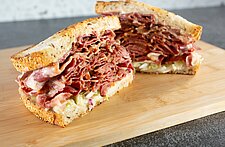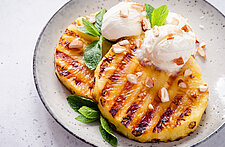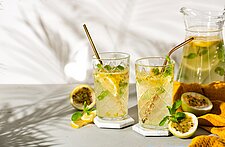(Cover Photo by travelspective.com)
Havana, Cuba, is once again a highly desirable and easily accessible travel destination, and one of the best restaurants in town, La Guarida, is a leading attraction on the world famous island. Enrique Nunez, a native of Cuba is in command as the Manager of La Guarida, a favorite stop among film celebrities, and increasingly growing in popularity and garnering world renowned praise. On a recent trip to Cuba, Emmanuel Laroche, Symrise’s leader of Marketing and Consumer Insights, interviewed Mr. Nunez, to talk about and explore the delights of Cuban cuisine.
Emmanuel Laroche: I enjoyed a wonderful lunch at La Guarida on a recent visit to Cuba and it sparked my curiosity about the profile of Cuban cuisine today - can you give us some background on the roots of delicious Cuban food?
Enrique Nunez: Like many other aspects of our culture – music, dance, religion, etcetera - our cuisine has African and Spanish roots. There is also an Indian influence. So like our architecture, you will find a mix, a combination of cultures that have influenced us. Its origins make it an eclectic cuisine.
EL: Is there an example of Cuban cuisine that you can define?
EN: Well, roast pork and black beans with rice are typical but this food did not originate in Cuba but came here through our Spanish and African ancestors. For instance. the Spaniards brought the pork while the Africans gave us the yucca. The family dinner is typically pork with yucca – it’s a perfect example of the African and Spanish impact on the foods we eat here in Cuba. Another typical food in Cuba is tamales – made with corn. Usually, on New Year’s Eve, you have an assortment of food from the Spanish, African and Indian traditions.
CLICK HERE to view A Franco-American in Cuba: 5 Genuine Moments that won't Soon be Forgotton
EL: How does this combination of traditions influence the food prepared at La Guarida?
EN: What we do at La Guarida is really what my wife, Odeysis, and I come up with. When we opened La Guarida, we really had limited experience or ideas about restaurants and food. I am an engineer by profession and my wife is an actress. We had to educate ourselves about what was happening in the restaurant world. We searched the wonderful restaurants in France, and came well acquainted with a restaurant in the south of France, where we learned a lot. So when we returned to Cuba, we adapted these techniques using Cuban ingredients. It is Nuevo Latino cuisine, what we call ‘the new Cuban cuisine’, influenced by the various Latin American and Hispanic cuisines we have mastered.

EL: What is the name of the restaurant in France that influenced you?
EN: Its name is La Ferniere www.aubergelafeniere.com/le-restaurant/”
EL: Yes, I know it as a very cool place. Now, as I understand it, using traditional techniques, Cuban ingredients are what really stand behind the creation of a modern Cuban cuisine, is that correct?
EN: That’s how it began but after that, we met a Cuban American chef (Douglas Rodriguez) and discovered and learned about Nuevo Latino which was gaining increasing awareness.
EL: In what part of Havana is your restaurant located?
The restaurant is located in the same area where I was born. I have eaten the food of these environs my whole life so it is a familiar cuisine. We are situated on the third floor of just a normal family house. Actually, we are in the heart of the city, not in a typical tourist location, making us interesting and different and demonstrating the history of Cuba – showing how people live. I think seeing all this is a wonderful experience for visitors to our country.
CLICK HERE to subscribe to the weekly in-sight newsletter
EL: When I dined at your restaurant, I was impressed by the huge number of celebrity photographs that were displayed. How did the restaurant become so popular among actresses and actors and people of note?
EN: I have to say that the film, Strawberry and Chocolate, had the greatest impact on our popularity. Originally, we were a successful private restaurant, a paladar, located on the third floor of a tenement in Central Havana. Here I was, an electronic engineer but I had read the story, Strawberry and Chocolate, and I was very interested in the fact that the film was to be shot in Havana. A friend of mine was an assistant director and was looking for a location so I suggested my parent’s house, which was eventually selected. By 1993, the film was acclaimed at the Havana Film Festival and even nominated for an Oscar. This awareness resulted in a lot of interest in the restaurant when people came to Havana although some were surprised by our location.

EL: It is indeed a beautiful building and when I visited Havana, it was great to observe all the renovations being done on the different floors of the building. It’s amazing what you have done to the restaurant that is located in this building - it is very impressive. Now, let’s continue. I imagine that people come to the restaurant expecting one dining experience and finding quite another. Do you think there are misconceptions about Latino cuisine and Cuban cuisine and if so, what is it exactly?
EN: People are familiar with commercial-type ethnic restaurants, the kind of Hispanic franchises you see all around you and it’s a misconception that these truly represent the scope of various cultures into one identity. When I went to Mexico and in Peru, I found there are restaurants that have authentic, amazing and different foods representing these cultures, foods I have never experienced in all my life, unfamiliar unless you travel there and experience it firsthand. Once, I went to a Cuban restaurant in Madrid, and I read on the menu, ‘Cuban Rice’ so I tried it. It was two fried eggs with tomatoes. The only way to experience a specific ethnic food is to travel to the place of origin and enjoy it in the actual country. And there are also different tastes that you get from different parts of a country. In the eastern part of Cuba, they make pork one way, different from how it’s made in the western part of Cuba – completely different even though it is the same meat. That’s why I think that the only way to discover the true taste of an ethnic food is to travel to the exact place of origin.
EL: Now I would like to know – from your personal viewpoint - which are the top ten ingredients that have influenced you in the past?
EN: We used a lot of herbs, I love using them. I love the herbs from Provence and we use a great many recipes that originate in Provence. We use herbs such as basil and parsley. Lately, I am working more with fruit, with the fruit flavors from the Caribbean. We are challenged to find in Cuba all the ingredients that we need to make it work. We need to work on Mother Nature to grow more ingredients. We are accustomed to using the lemons and onions in ceviche and tartare. We rely on fresh ingredients that we have.
EL: What specific Caribbean foods have inspired your menu?

EN: One of the most successful recipes that we prepare at our restaurant is Tuna and Sugar Cane. We use a lot of coconut and mangoes and cilantro and onions. We feature a recipe called ‘Tropical Chicken’ made with pineapple and papaya.
EL: What inspired you to create your Papaya Lasagna? I enjoyed it at your restaurant – what inspired you to create it?
EN: We are always inspired to surprise the person who is dining at our restaurant – once again, trying to use ingredients native to our country. We grow papaya throughout the year, so fresh papaya is always available. We use the basic fresh lasagna recipe using papaya and it changes the taste and the color and the aroma. We also make duck using citrus compote – lemon, orange, and cilantro - a combination that turns out very fresh tasting, very nice.
CLICK HERE to view more Latin insights on in-sight.symrise.com
EL: What new dishes are you considering for your menu?
EN: We try to create new recipes that we will be able to keep on the menu. We’re limited to what we can find at the market if we’re going to feature something on a regular basis. We need ingredients that are easy to find, when the markets are open. Look, you cannot get beef all year long, so it is not on the menu all year long. We want to keep things fluid so we can prepare consistently good offerings.
EL: Are you ever inspired by a new ingredient that you happen to find in the marketplace? An ingredient that is so fresh that you want to build a recipe around it?
EN: I am always inspired when I go to the fisherman’s house in Cuba because we have wonderful varieties. So when I see something new, I am inspired to do something special with it. I also like to read books about restaurants and also recipe books and I like to adapt the recipes to include our ingredients. Also, as I said – when I travel and taste a flavor that is new to me, I try to imagine what will happen when I cook with it in my country. I think about what our version of the dish will be. So I create my own interpretation of the recipes I learn about.
EL: What are your favorite flavors to work with?
EN: I love the flavors that make you remember Cuba – that when you taste it, you say, ‘Okay, this tastes like Cuba’. I know people love our cigars so we have made a cod dish – a bacalao -with the taste of the smoke found in our excellent Cuban cigars. This is one of the most diverse things I have ever done – something you are not likely to find anyplace else but La Guarida. I just like to make dishes that surprise you. You need time in a restaurant to prepare menu items in advance – the kind of menu item that will make people say 'Wow!’ because its great taste surprises you. The difference in preparing food at home compared to a restaurant is the time you need to prepare different menu items at a restaurant in the correct quantities. I like to play with the flavors we use – like lemon juice and different fruits – and that takes time.

EL: In reference to the use of cigar smoke taste in the new cod recipe that you make – do you consider this to be your most creative dish or is there another that you think is your most creative?
EN: It’s hard for me to choose – because we really love all the recipes we have on our menu but some recipes stand out because they are so interesting. We use orange in some of our recipes that people really love - it’s tender sweetness is really appealing.
EL: Let’s turn to desserts – which desserts are most associated with Cuban cuisine?
EN: I love the many desserts that we offer. We have Cuban varieties and also those inspired by Puerto Rican cuisine. We make delicious custards and ice creams using coconut, mango, papaya and a French pastiche – with anise taste.
EL: Regarding beverages, I had a wonderful cocktail and also enjoyed terrific mojitos and the famous Cuba Libre. At your restaurant, I had the most fantastic after dinner drink – the one made with coffee and cream – it is distinguished by different layers.
EM: We use a special coffee for that drink, with a touch of cinnamon, lemon and Rum– these flavors explode in your mouth. We make a lot of different cocktails and have distinguished ourselves among our competitors from all over the world in various international contests. We use typical Cuban ingredients such as yerba buena, marmalade, sugar, pineapple and white rum. A favorite is a cocktail named La Mansion, named after the building where our restaurant is located.
EL: In conclusion, how do you see Cuban cuisine evolving, not only at your restaurant but in Cuba?
EM: With more people coming to Cuba, especially Americans, there are more opportunities for restaurants to feature their own specialties. Previously, when visitors came to Cuba, they would find all the restaurants having the same basic menus – the same creamy items and the same cordon bleu. But today, we have the opportunity to create our own versions of recipes to please our customers. It’s a new movement in gastronomy where we can all be competitive because we all want to do our best. Over the past 20 years, there has been a big change throughout the entire country. I don’t want to compare Cuba with Spain or even Mexico since we do have our own culture. I am optimistic that Cuban gastronomy will become a top cuisine the way it was before 1959 when it was highly praised and admired.
EL: Yes, the difference is clear in what were previously government owned restaurants with all the same menus and today’s diverse dining places - very different from what was served in 1996 and prior to that. Your observations have been an excellent learning opportunity for us. At this point, we will draw our interview with you to a close with deep appreciation for all that you have shared with us.
EM: Thanks for the opportunity to spread the word, not only about our restaurant but about Cuba, our country and its wonderful comeback.




